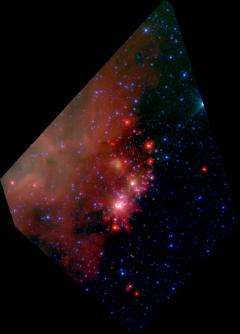Young Star Clusters

(PhysOrg.com) -- Most stars form in clusters. Recent studies of nearby star forming regions find that about three-quarters of their young stars are located in groups with ten or more members. The formation of stars in clusters is thus a central feature of the study of how stars are made. The presence of the cluster highlights the possible roles of many other physical phenomena in the birth, for example, the effects of the massive amounts of gas always found in young clusters, or the possibly disruptive interactions between embryonic stars in the crowded womb. It has even been suggested that massive stars form from the coalescence of smaller, neighboring stars.
Since it seems likely that our sun also formed in a cluster of stars, astronomers studying the birth of stars have been looking with interest at young clusters of stars. The task is not an easy one, however. Young stars in clusters are nearly always embedded within their natal clouds where large quantities of dust obscure the visible light, making comprehensive optical studies from the ground difficult, if not impossible. A solution has come from infrared cameras, especially those on the Spitzer Space Telescope which can see deep into the dust clouds and detect even faint, new stars.
CfA astronomers Rob Gutermuth, Phil Myers, Lori Allen, and Giovanni Fazio, along with two colleagues, used the infrared cameras on board Spitzer to make the first uniform, detailed mid-infrared study of thirty-six star-forming groups within about 3000 light-years of earth (they contain about half of all the regions with clustering that have been cataloged out to this distance). Their new paper, which is the first in a series, identifies and classifies 2,548 young stars less than about a few million years old.
Using a statistical analysis of the spatial distributions of these young stars within their cluster, a technique that they perfected for this study, the scientists show that most stars (62% in this study) reside in one of thirty-nine clusters (some regions contain more than one cluster). The median diameter of a cluster is about 1.2 light-years, and the median separation of the young stars is only 0.2 light-years (for comparison, the nearest star to the sun today is 4 light-years away). The new results include enough objects that the conclusions can reliably address some general properties about the formation of stars in clusters.
Provided by Smithsonian Astrophysical Observatory



















